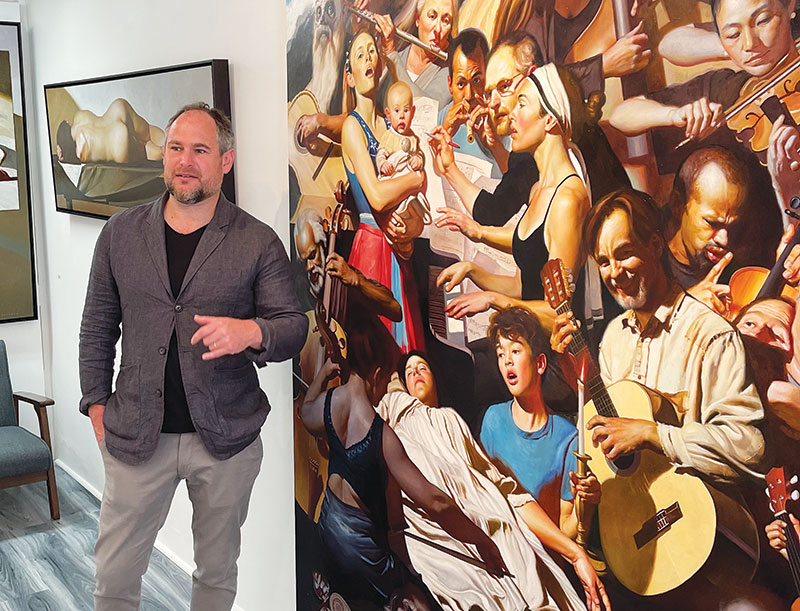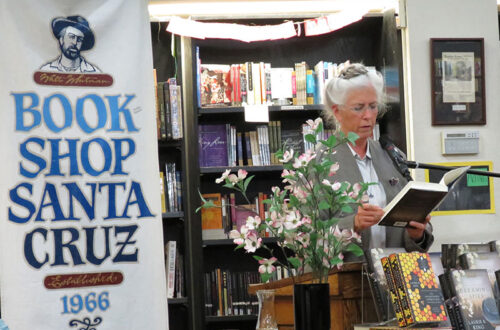
Buchanan Turns Childhood Passion Into Full Time Profession
Santa Cruz painter Noah Buchanan began his studies in classical drawing, painting and anatomy at the Pennsylvania Academy of the Fine Arts in Philadelphia. After taking a BFA from UCSC, he received a Masters of Fine Arts from the New York Academy of Art. Buchanan lives in Santa Cruz and teaches painting and drawing at several colleges and universities in the Bay Area. And his paintings are featured in private and public collections in the US and Europe.
Q: How you decided that painting was the career for you?
NB: I enjoyed drawing since I was very young, it was always my primary source of entertainment as a child. I constantly had a pencil in my hand and a pad of paper at my side. Family, friends and peers all labeled me as an artist. So by the time I was in 6th grade, I had mapped out where I would go to art school, and how I would make a living as an artist … real life didn’t exactly match my 6th grade plan, but then again it wasn’t far off!
Q: Talk about the unique challenges, and satisfactions of working on large-scale paintings.
NB: Making a large-scale painting is like making a movie. Early rough sketches and studies are the equivalent of a screenplay, and the process of finding models to pose for the painting is the same as casting actors to play the parts. Lighting, special effects, costumes, there’s a lot of planning and research.
Making a large canvas has the epic feel of seeing a story play out on “the big screen”. The life size scale of the figures makes the viewer feel they are a part of it. That’s very exciting.
Q: How did the idea for Symphony come about?
NB: I hang on to ideas and concepts for paintings in sketchbooks for years. In the case of Symphony,[oil on canvas, 96” x 70”] I’d had an idea for a painting almost 20 years earlier about a large group of people all gathered around a piano, all singing, yet one person was either asleep, or ill, or deceased. When I decided to return to that idea, I began sketching it out more elaborately. As the sketch unfolded, I could see that I was creating a piece where everyone was making music in different ways – not just with different instruments but with different moods and intentions, and that this was really a metaphor for our collective experience of life.
Q: Did you include your friends, family, in this piece?
NB: The painting is fully loaded with friends and family and self-portraits (I appear in the painting 4 times). This is common for a lot of painters simply because they don’t want to have to go on a major time-consuming search to find people to pose. Once an artist has an idea for a painting, they want to get started on it immediately, and so they often look to the people who are closest at hand. But after three or four paintings like this, the same characters continue to appear from painting to painting.
Q: How do you balance the time it takes to dive into the creative work, with a teaching schedule?
NB: I teach college level drawing and painting two days a week, which affords me the ability spend the rest of the week in my studio. It helps a great deal that my studio is at home in an old garage converted into a painting studio. This means that I can work on paintings in the hours between dinner and bedtime. But having a painting career also means sacrifices, keeping a smaller group of friends, it means not going out on weekends, trimming away unnecessary hobbies.
Q: Would you recommend painting to young people even if they aren’t considering it as a lifetime career?
NB: Painting as a profession is serious business. It’s hard work and takes years practice and dedication, and even then, it doesn’t always turn out right. I recommend it only to people who feel that they must do it. But I recommend the practice of drawing to everyone of all ages. When I was young, drawing was fun, exciting, entertaining, and rewarding as I saw myself improve. Anyone can do it with a pencil, or pen, and any kind of paper laying around. Drawinglets you explore ideas or invent stories. Drawing is an enriching practice that profoundly changes the way we visually experience the world. It’s a strengthening practice for the mind as well in that we learn to think about relationships of form, structure and light.
By Christina Waters






